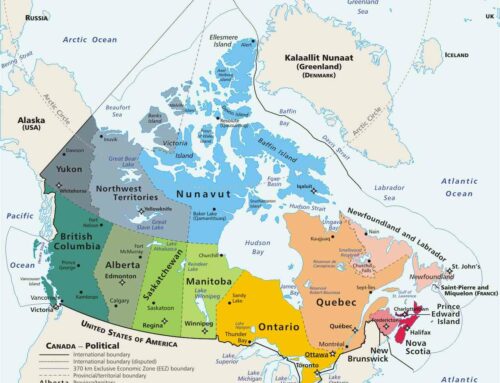When one thinks of the term “melting pot”, it can either call to mind a bubbling vat of cheese fondue, or in more global conversations, a country that has a widely diverse and accepting culture. And in the case of the latter, arguably one of the best melting pots in the world is the friendly land of beavers and hockey: Canada.
In 2016, a Canadian survey reported over 250 ethnic populations scattered across the country. It’s a fact that has influenced the overarching Canadian persona since its inception, leading to what is now an amorphous national identity that is defined by having a multitude of identities mixed together.
Still, amidst all this ethno-cultural mingling between Canadians, a set of social customs and norms have emerged that have helped give Canadian culture some shape. Although these rules do differ a bit between French and English Canadians, the guide below will help you navigate all the pertinent norms when you make the move to Canada. After reading, you’ll have a big step up in making a good (and beautifully normal) first impression.
Let’s get started.
SECTION #1 – MEETINGS AND GREETINGS
HOW DO I GREET A FELLOW CANADIAN?
Greetings are always a bit tricky in a new culture. Some countries go for a handshake. Others, a hug. And don’t get us started about the complicated cheek kissing etiquette found around the world. Fortunately, in Canada, we keep things pretty simple.
For English Canadians, greeting someone new can be done with a firm handshake while looking them in the eye. If you’re already familiar with someone, a gentle hug is also acceptable. In French-Canada, it’s encouraged to greet someone new or familiar with a kiss on both cheeks—very European in nature.
Of course, with Canada’s plethora of ethnicities, you may come across some unique greeting modes that may seem totally unfamiliar.
WHAT SHOULD I CALL MY CANADIAN FRIEND? WHAT ABOUT MY BOSS?
Canadians typically call their friends and family by their first name. However, when meeting someone new, you may be introduced with both a first and last name. In that case, it’s polite to refer to that person as Mr. or Mrs. [insert last name], unless directed otherwise.
That same rule applies to your boss: it’s formally appropriate to address them as Mr. or Mrs. [insert last name], until they instruct you to call them something else.
ARE THERE ANY BODY LANGUAGE RULES IN CANADA?
In Canada, it’s totally common to see Canadians sitting with crossed or outstretched legs. That isn’t a sign of offense—it’s just comfortable!
Regarding conversations, it’s polite to maintain direct eye contact, as that shows you’re paying attention with active listening. However, it is inappropriate to stare at others that may seem physically different in any way. Similarly, pointing at others is considered bad form. Best to keep your hands to yourself.
HOW MUCH PERSONAL SPACE SHOULD I GIVE OTHERS?
Canadians like their personal space as much as they like maple syrup: a lot. In conversations, careful not to get too close to your counterpart; in some cases, it can be seen as a sign of aggression. If you’re making an emphatic point in a conversation, it’s best to do it with your voice and not your hands.
WHAT SHOULD I TALK ABOUT WITH CANADIANS?
This is a tricky one. Some Canadians love to talk about sports, especially Hockey, Basketball, Baseball and the Canadian Football League. But not everyone finds the world of athletics interesting. Some other conversation points can be fashion, economics, science and in some cases, even politics. Just don’t bring up anything related to Quebec’s separatist notions—that can be a bit of a sore spot for some.
WHAT IF A CANADIAN ASKS ME HOW I AM?
The phrase “how are you?” or “how’s it going?” is very popular in Canada. Most of the time, it isn’t actually a question. It’s simply a polite substitute for saying “hey”. Instead of responding with an elaborate answer, you can simply say “fine, thanks” and proceed with the next phase of conversation.
HOW DO CANADIANS USE THE WORD “SORRY”?
Canadians say the word sorry more than any other country in the world. In fact, it has been overused so often in Canadian culture, it’s become a bit of a reflex. Sometimes, people will say “sorry” to get your attention, without intending to actually apologize. Other times, they’ll say “sorry” before a request, because they understand their request will inconvenience you in some way. If you aren’t sure when it’s appropriate to use the word, just go ahead and use it anyways. Chances are, you’ll be right.
SECTION #2 – PARTIES, GIFTS AND MORE
WHAT GIFT DO I BRING TO A CANADIAN FRIEND’S PARTY?
There are a few circumstances where it’s appropriate to give a gift after receiving an invite somewhere. Do note that it’s always acceptable for the recipient to open their gift immediately after receiving it!
If someone invites you to their home for dinner, an appropriate gift to bring is either a decent bottle of wine, a bouquet of flowers or some chocolate. Even bringing a green plant is seen as a very favourable gift. It’s also polite to reciprocate with an invitation to your home sometime in the future.
If you’re invited to a birthday party, you can bring a small gift if you know the person well. Gift cards and clothes are always a good bet. However, for adult birthday parties, it’s often enough just to show up with nothing but a smile: Canadians love bringing groups of friends together over birthday celebrations.
If you’re going to a holiday party, you can usually bring a dish to contribute to the dinner. Ask the host ahead of time if they’re in need of a good appetizer or some dessert.
For business parties, sometimes people exchange gifts if its around the holidays. But that is definitely not a requirement.
HOW DO CANADIANS TIP?
Canadians typically give 15% of a bill as tip for their restaurant servers and taxi drivers, and sometimes drop $1 – $5 for small-scale workers that assist you in anyway (think hotels, etc.)
WHAT IS TABLE ETIQUETTE LIKE IN CANADA?
Canada follows traditional eating styles, keeping the fork in the left hand and the knife in the right. In some more polished environments, it’s appropriate to transfer the fork to the right hand before taking a bite.
In English-Canada, it’s polite to keep your elbows off the table at all times. However, in French-Canada, men typically rest their forearms on the table during the meal while women rest their wrists. After the meal is done, both parties can put their elbows on the table.
If you’re wondering when you should start eating, the best practice is to wait for the hostess to begin before diving in to your meal.
HOW SHOULD I APPROACH ALCOHOL IN CANADA ?
When it comes to parties, drinking is a very common occurrence. Beer is definitely a crowd favourite, but the older crowds will usually indulge in wine. In either case, be sure not to overdo it—alcohol can bring out some unsavoury qualities that might be frowned upon in Canada. And that’s especially true at business events.
The legal drinking age in Canada is 19 years old in all provinces except Quebec, Manitoba and Alberta (where it’s 18 years of age). Since Canadians can get their driver’s license at the early age of 17, drinking and driving is considered a very serious offense and is punished severely. Do not do it.
At restaurants, it’s common to get a drink with your meal. But don’t feel obligated—drinking at restaurants can lead to a pretty expensive bill.
IS SMOKING ACCEPTABLE IN CANADA?
As of October 17th, 2018, smoking marijuana has become legal in Canada. It was a triumphant day for Canadians everywhere, and is seen as a very progressive step for the country. However, that doesn’t mean it’s appropriate to smoke in public.
In fact, Canada’s attitude towards smoking (both cigarettes and marijuana) is that it’s okay to do in the privacy of your own home, but considered very bad taste to do it in front of others without their consent.
Canada has been a forerunner in anti-smoking legislation, so you’ll be hard-pressed to find a restaurant that allows smoking in Canada.
SECTION #3 – THE BUSINESS WORLD
CAN MY CANADIAN COLLEAGUES BE MY FRIEND?
Making workplace friends is incredibly easy in Canada, especially with the jovial and friendly attitude most Canadians carry with them. But be warned: while it’s great to share a laugh and a drink with some colleagues, most associates of yours will be reluctant to share details of their personal lives.
With a country-wide focus on productivity and efficiency, a lot of your workplace friends will save the niceties until after the workday is done—otherwise known as the glorious time of “happy hour”.
When it comes to genders in the workplace, women and men are viewed as total equals. You should treat all genders with respect, and keep your distance so as not to send unwanted signals.
WHAT SHOULD I WEAR TO WORK?
This question depends on how big (or small) your company is. If it’s a small start up, or a company that deals with creativity (like advertising), it’s common to wear business casual attire like jeans and a shirt. However, if your company is bigger and deals with finances or other big industries, the dress code is usually more business formal wear like a suit and tie for men and a smart dress or skirt for women.
HOW SHOULD I APPROACH MEETINGS IN CANADA?
In the business world, meetings are how team members align and get things done. While some people view them as a little inefficient at times, they’re a fundamental part of the working world—without them, your eyes wouldn’t forgive you from staring at a screen all day.
In English-Canada, meetings start with a bit of small talk before getting down to business. All team members, whether junior or senior, are encouraged to speak in meetings to give a sense of equality throughout the workplace.
Alternatively French-Canadians center their meetings around the senior members of the team out of respect for hierarchy. The first few minutes of meetings are usually used for relationship building.
WHAT ABOUT CANADIAN PRESENTATIONS?
Just like the way we communicate, Canadians expect presentations to be succinct and direct. It’s encouraged to back your presentation up with substantial facts and figures, and a PowerPoint presentation is usually included for visual cues. If you can, try to memorize your presentation before hand. It creates a sense of expertise that will take you very far in the working world!
NEXT UP: PRACTICE WHAT WE PREACH
At the end of the day, the only way to master all these cultural norms is to start practicing. Through over 20 years of experience, the team at ARIANNE has mastered cultural integration. That’s why we offer customized intercultural training programs to help you translate your way of life to the incredible Canadian culture. So grab your suitcase, consult our guide to Canadian slang, and get ready to make the wonderful leap to the Great White North!
LEARN MORE
For more information about Canadian cultural nuances, check out the following articles and links:








Leave A Comment